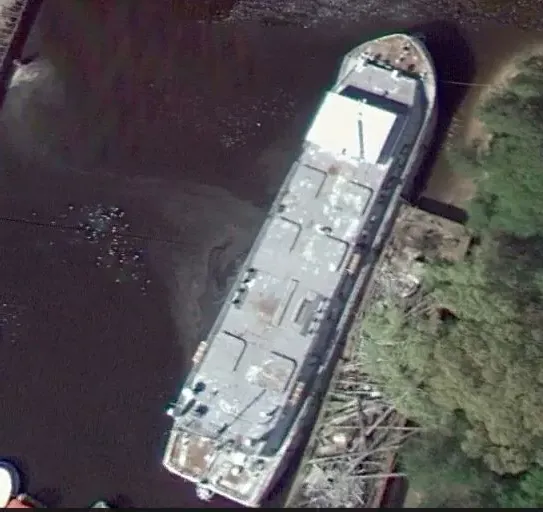Environmental Law Eliminates a Floating Junkyard (Part 1 of 2) - June 2016
By Jim Lang - June 2016
People who own waterfront property need to know how they can protect their property from the threat of ruin when other persons inappropriately and improperly occupy the waterfront adjoining their land. Riparian property rights are often the greatest element of value for waterfront land. This article describes how one family used environmental law to protect its $6M property after their neighbor choked off the waterway with a fleet of rusting, unsightly, dilapidated ships. This article also is of interest to any business or organization facing the threat of environmental citizen suit litigation. This is part 1 of a 2-part article.
The Next Door Neighbor Starts Collecting Ships

The story opens with two properties on a 200+ foot wide fully navigable waterway that offers ready access to the Elizabeth River in Norfolk. The neighbor who owns the 1-acre parcel outlined in red in the photo on the right, we will call him Mr. Collector, is responsible for 26 of the 30 vessels seen in the photo, including all of the large ones (e.g. 175' long and above). The neighbor who owns the 7-acre parcel with a black border, valued at $6M, is responsible for four of the vessels, and none of the large ones. We call him Mr. Landowner.
Friendly Request to Remove Ships Fails

Mr. Landowner is concerned that Mr. Collector's ships are blocking navigation in the waterway but, equally concerning, many of Mr. Collector's vessels are in poor condition or are sitting on the river bottom. Mr. Landowner asks Mr. Collector to remove the vessels but Mr. Collector says "no".
legally required disclaimer:
CASE RESULTS DEPEND UPON A VARIETY OF FACTORS UNIQUE TO EACH CASE. CASE RESULTS DO NOT GUARANTEE OR PREDICT A SIMILAR RESULT IN ANY FUTURE CASE UNDERTAKEN BY THE LAWYER.
end of legally required disclaimer.
Mr. Landowner Hires Environmental Attorney Jim Lang at Pender & Coward in Virginia Beach
The (Failed) Effort to Secure Assistance From Government Agencies
Because lawsuits are expensive, I looked for alternative ways to clean up the mess in the water next to Mr. Landowner's property. Mr. Landowner pays his taxes, and the Floating Junkyard is so obviously improper, I believed that the government agencies with jurisdiction could be counted on to help. I met with the Deputy City Attorney, the U.S. Coast Guard, the U.S. Army Corps of Engineers, the Virginia Department of Environmental Quality, the Virginia Marine Resources Commission, and I contacted U.S. EPA by telephone and email, to show them the photos and to ask them – each of them -- to force Mr. Collector to remove the ships. The bureaucrats at these agencies all said that the problem was most unfortunate. Some said that Mr. Collector had been a problem for years. One said that this cove "is the worst cove in Norfolk". But all of them explained that their power to help was extremely limited due to underfunding of their enforcement budgets and other higher priority enforcement matters.
The (Successful) Effort to Secure Assistance From Television Media

I next turned to Rubin Communications Group to arrange for television stations to show Mr. Landowner's problem on local media newscasts. After the television coverage began to take hold some of the government agencies called a meeting with Mr. Collector and, over the next few months he removed a half-dozen of the smallest vessels from the fleet.
More media attention and, a few months later, one of the agencies, the Virginia Marine Resources Commission (VMRC) ordered Mr. Collector to remove four vessels "from state-owned bottom". Mr. Collector removed two of the four vessels from the waterway and then he persuaded the VMRC law enforcement officer that the order should be canceled as to the other two vessels because they lift off of the "state-owned bottom" some of the time, after which they settle back onto the river bottom, upon which the VMRC law enforcement officer canceled the order for those two vessels and they remained in the waterway. These two vessels for which the removal order was canceled were the two largest vessels in the waterway.
One was 245 feet long.

The other was 262 feet long.

Both sat on the river bottom 80% of the time, temporarily lifting off the bottom only when the tides were at the highest level. I urged the VMRC law enforcement officer to require these ships to be removed from state-owned bottom 100% of the time but got nowhere. I took the matter up with the Colonel at VMRC who supervised the law enforcement officer but again got nowhere. The government agencies told me that they had now done all they could do to help Mr. Landowner. The U.S. Coast Guard sent me a letter certified mail, return receipt requested, telling me that the Coast Guard will not take any action. The waterway remained choked with Mr. Collector's large vessels, several of which were aground.
This is Part 1 of a 2-part Article. Next: Mr. Landowner Files a Citizen’s Environmental Lawsuit Against Mr. Collector
Contact our waterfront law team with any questions.
